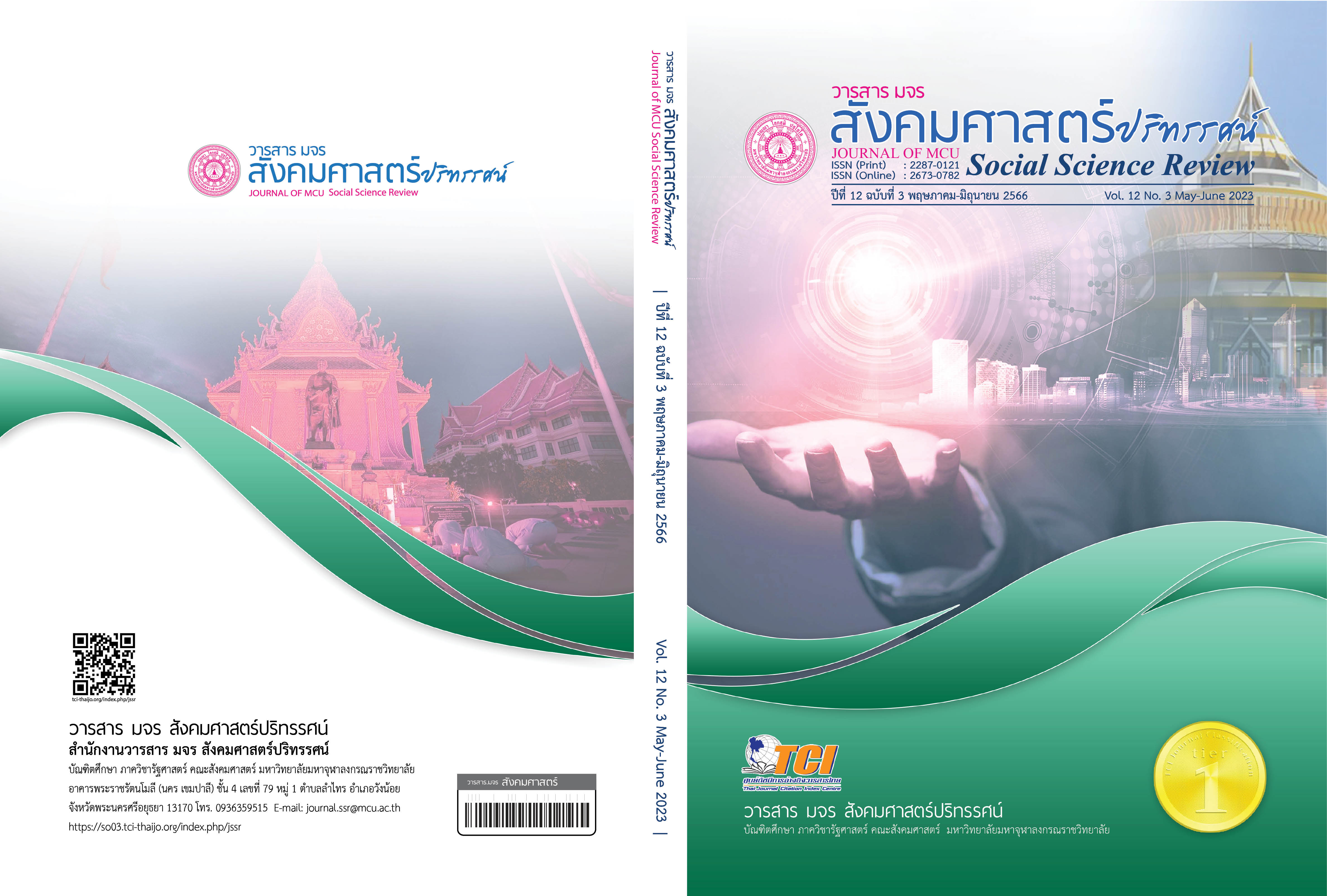แนวทางการพัฒนาโบราณสถานคอกช้างเผือกแหล่งท่องเที่ยวเชิงประวัติศาสตร์และวัฒนธรรม อำเภอแม่สอด จังหวัดตาก
คำสำคัญ:
การพัฒนา, โบราณสถาน, คอกช้างเผือกบทคัดย่อ
บทความวิชาการนี้มีวัตถุประสงค์ 1. เพื่อศึกษาสภาพปัญหาการบริหารจัดการโบราณสถานคอกช้างเผือก 2. เพื่อเสนอรูปแบบการพัฒนาโบราณสถานคอกช้างเผือกให้เป็นสถานที่ท่องเที่ยวเชิงประวัติศาสตร์และวัฒนธรรม พบว่า มีการใช้พื้นที่โบราณสถานคอกช้างเผือกผิดวัตถุประสงค์โดยถูกนำไปใช้เป็นสถานที่จอดรถและเป็นเส้นทางผ่านสำหรับบุคคลที่เดินทางไปมายังประเทศเพื่อนบ้านเพื่อเล่นการพนันหรือซื้อสินค้าปลอดภาษีที่ตั้งอยู่บริเวณริมแม่น้ำเมยใกล้กับโบราณสถาน ปัญหาความปลอดภัยของโบราณสถานซึ่งเป็นพื้นที่โล่งและเป็นอิฐที่ง่ายต่อการพุพัง อีกทั้งยังขาดความร่วมมือระหว่างหน่วยงานต่าง ๆ และประชาชนในการทำนุบำรุงสถานที่อย่างต่อเนื่อง ขาดการพัฒนาผลักดันสถานที่ให้เป็นแหล่งท่องเที่ยว ซึ่งโบราณสถานคอกช้างเผือกเป็นสถานที่ที่มีความสำคัญจึงควรพัฒนาโบราณสถานคอกช้างเผือกให้เป็นสถานที่ท่องเที่ยวเชิงประวัติศาสตร์และวัฒนธรรมโดยการเสนอแนวทางการพัฒนาคือรูปแบบปกปักรักษา แบ่งการพัฒนาออกเป็น 12 ด้าน ดังนี้ 1. ด้านการมีส่วนร่วม 2. ด้านความรับผิดชอบ 3. ด้านความเชี่ยวชาญ 4. ด้านความปลอดภัย 5. ด้านการพาณิชย์อิเล็กทรอนิกส์ 6. ด้านกฎระเบียบและกฎหมาย 7. ด้านการเรียนรู้เสมือนจริง 8. ด้านการบริหาร 9. ด้านเทคโนโลยีและสารสนเทศ 10. ด้านความสัมพันธ์ระหว่างประเทศ 11. ด้านความเป็นเจ้าของ 12. ด้านเครือข่าย ทั้งนี้เพื่อให้การบริหารจัดการเป็นไปอย่างมีประสิทธิภาพและประสิทธิผลและส่งผลให้โบราณสถานเป็นที่รู้จักของผู้คนทั้งในประเทศและต่างประเทศต่อไป
เอกสารอ้างอิง
กรมส่งเสริมการปกครองท้องถิ่น กระทรวงมหาดไทย. (2564). ความหมายและความสำคัญของโบราณสถาน โบราณวัตถุ พิพิธภัณฑ์และจดหมายเหตุ. สืบค้น 18 พฤษภาคม 2564, จาก http://www.dla.go.th/work/e_book/eb1/std210550/28/4.pdf
กรมศิลปากร. (2564). ประกาศกรมศิลปากร เรื่องขึ้นทะเบียนโบราณสถาน (โบราณสถานคอกช้างเผือก กรุงเทพมหานคร). สืบค้น 18 พฤษภาคม 2564, จาก https://www.finearts.go.th/main/view/9280
กรมส่งเสริมวัฒนธรรม. (2559). วัฒนธรรม วิถีชีวิตและภูมิปัญญา. กรุงเทพฯ: รุ่งศิลป์การพิมพ์ จำกัด.
ไกรราชกช พลรัตน์. (2559). รูปแบบการฝึกอบรมยุวมัคคุเทศก์เพื่ออนุรักษ์สิ่งแวดล้อมในแหล่งท่องเที่ยวโบราณสถานสต๊อก๊อกธมด้วยกระบวนการสิ่งแวดล้อมศึกษา (วิทยานิพนธ์ หลักสูตรปริญญาปรัชญาดุษฎีบัณฑิต สาขาวิชาสิ่งแวดล้อมศึกษา) ปทุมธานี: มหาวิทยาลัยราชภัฎวไลยอลงกรณ์.
ชยาภรณ์ สุขประเสริฐ และคณะ. (2562). การพัฒนาจิตสำนึกสาธารณะเพื่อการอนุรักษ์โบราณสถานชุมชน จังหวัดบุรีรัมย์ (รายงานการวิจัย). บุรีรัมย์: มหาวิทยาลัยมหาจุฬาลงกรณราชวิทยาลัย วิทยาลัยสงฆ์บุรีรัมย์.
นภสร โศรกศรี. (2562). อัตลักษณ์วิถีวัฒนธรรมชุมชนตะปอน อำเภอขลุง จังหวัดจันทบุรี : การจัดการเพื่อพัฒนารูปแบบการท่องเที่ยวอย่างยั่งยืน (ดุษฎีนิพนธ์หลักสูตรปรัชญาดุษฎีบัณฑิต สาขาวิชาการบริหารศิลปะและวัฒนธรรม). ชลบุรี: มหาวิทยาลัยบูรพา.
ปรียา หิรัญประดิษฐ์. (2564). ความรู้จากสารานุกรมสุโขทัยศึกษา. สืบค้น 18 พฤษภาคม 2564, จาก https://www.stou.ac.th
พีรวัชร์ ราชิวงศ์.(2561). แนวทางในการอนุรักษ์โบราณสถานในวัดมณีวนาราม จังหวัดอุบลราชธานี (วิทยานิพนธ์ ตามหลักสูตรปริญญาพุทธศาสตรมหาบัณฑิต สาขาวิชาพระพุทธศาสนา) พระนครศรีอยุธยา: มหาวิทยาลัยมหาจุฬาลงกรณราชวิทยาลัย.
มติชนออนไลน์. (2564). ปิดเส้นทางโบราณสถานคอกช้างเผือก. สืบค้น 18 พฤษภาคม 2564, จาก https://www.matichon.co.th/newsmonitor/news_716496
ศศิพร ต่ายคำ และคณะ. (2562). การพัฒนารูปแบบการสื่อสารการตลาดออนไลน์สินค้าเกษตรอินทรีย์ของวิสากิจชุมชน (รายงานการวิจัย). กรุงเทพ ฯ: มหาวิทยาลัยสวนดุสิต.
สำนักงานราชบัณฑิตยสภา. (2564). ความหมายโบราณสถาน. สืบค้น 25 มีนาคม 2564, จาก https://www.dictionary.orst.go.th
ดาวน์โหลด
เผยแพร่แล้ว
รูปแบบการอ้างอิง
ฉบับ
ประเภทบทความ
สัญญาอนุญาต
ลิขสิทธิ์ (c) 2023 วารสาร มจร สังคมศาสตร์ปริทรรศน์

อนุญาตภายใต้เงื่อนไข Creative Commons Attribution-NonCommercial-NoDerivatives 4.0 International License.
เพื่อให้เป็นไปตามกฎหมายลิขสิทธิ์ ผู้นิพนธ์ทุกท่านต้องลงลายมือชื่อในแบบฟอร์มใบมอบลิขสิทธิ์บทความให้แก่วารสารฯ พร้อมกับบทความต้นฉบับที่ได้แก้ไขครั้งสุดท้าย นอกจากนี้ ผู้นิพนธ์ทุกท่านต้องยืนยันว่าบทความต้นฉบับที่ส่งมาตีพิมพ์นั้น ได้ส่งมาตีพิมพ์เฉพาะในวารสาร มจร สังคมศาสตร์ปริทรรศน์ เพียงแห่งเดียวเท่านั้น หากมีการใช้ภาพหรือตารางหรือเนื้อหาอื่นๆ ของผู้นิพนธ์อื่นที่ปรากฏในสิ่งตีพิมพ์อื่นมาแล้ว ผู้นิพนธ์ต้องขออนุญาตเจ้าของลิขสิทธิ์ก่อน พร้อมทั้งแสดงหนังสือที่ได้รับการยินยอมต่อบรรณาธิการ ก่อนที่บทความจะได้รับการตีพิมพ์ หากไม่เป็นไปตามข้อกำหนดเบื้องต้น ทางวารสารจะถอดบทความของท่านออกโดยไม่มีข้อยกเว้นใดๆ ทั้งสิ้น





